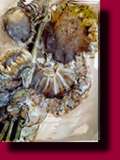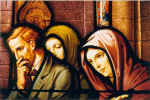
|
|||
|
Mes recherches iconographiques seront donc basées (au fils des 9 fenêtres principales) sur le thème des nouvelles technologies, et des nouveau média dans l'art, et ce, pour plusieurs raisons: - Il me semblait intéressant de traiter un sujet portant sur les nouveaux modes d'expressions artistiques et l'utilisation des innovations technologiques, comme le numérique , alors que le vitrail est un mode d'expression des plus traditionnel. - J'aimerais également soulever la question de l'alliance, parfois difficile, des métiers d'art et de la technologie. Les métiers d'arts, aux origines particulièrement anciennes, trouvant leurs fondements dans l'agilité manuelle et un savoir faire traditionnel, semblent redouter l'instrument menaçant et déshumanisant qu'est l'ordinateur! Le numérique s'est pourtant introduit dans tout les domaines de l'art contemporain: la photographie, le cinéma, la musique électronique, dans les œuvres sur CD-ROM, etc. Il confère à l'image une nouvelle faculté: une malléabilité infinie. Dés lors que celle-ci est traduite en langage numérique, elle peut être modifiée dans ses moindres éléments; par le truchement de l'ordinateur, elle devient "information", et toute information se prête à manipulation. L'image n'est plus fixe elle devient un système dynamique. - Je tiens également à me tourner vers l'avenir et m'attarder sur un phénomène toujours en cours et en évolution constante. Tout comme certain artistes exploitent l'ordinateur comme un "outil" de création (Richard Prince dont les abstraction prennent forme dans un ordinateur avant d'être peintes sur la toile ,l'ensemble de l'œuvre de Keith Cottingham, cf doc…), j'utilise l'ordinateur qui offre la possibilité de manipuler un matériau source (une photographie, des dessins…)grâce au langage informatique. Les photographies ou dessins sont numérisés par l'intermédiaire d'un scanner, processus aujourd'hui très simple par lequel une image bidimensionnelle est interprétée dans le langage mathématique binaire ou numérique de l'ordinateur. Le matériau source devient malléable, car entièrement décomposé en chiffre indépendants. Partant du principe que cette chapelle ne possède pas de réel intérêt architectural, j'ai choisi de m'orienter vers des compositions colorées et rythmées pour contraster avec la sobriété des lieux. Il ne sera pas question pour moi de mettre les vitraux au service de l'architecture, ni d'un quelconque mysticisme. My iconographic research will thus be based (all alongf the 9 principal windows) on the topic of new technologies, and the new media in art, and this, for several reasons: - It seemed to me interesting to cover a bearing subject on the new fashions of artistic expressions and the use of the technological innovations, like the numerical one, whereas the stained glass is a traditional mode of expression. - I would also like to raise the question of the alliance, sometimes difficult, of the trades of art and technology. The trades of arts, in the particularly old beginnings, finding their bases in the manual agility and a knowledge to make traditional, seem to fear the threatening and dehumanizing instrument which is the computer ! The numerical technology was however introduced into all the fields of the contemporary art: photography, the cinema, electronic music, in works on CD-Rom, etc. It confers on the image a new faculty: an infinite malleability. Dice at the time this one is translated into numerical language, it can be modified in its least elements; by the means of the computer, it becomes "information", and any information lends itself to handling. The image is not fixed any more it becomes a dynamic system. - I also hold to turn to the future and to be delayed on a phenomenon always in progress and in constant evolution. Just like certain artists exploit the computer as a "tool" for creation (Richard Prince whose abstraction take form in a computer before being painted on the fabric, the whole of the work of Keith Cottingham, cf Doc....), I use the computer which makes it possible to handle a material source (a photograph, drawings...)grâce with the data-processing language. The photographs or drawings are digitized by means of a scanner, very simple process today by which a two-dimensional image is interpreted in the binary or numerical mathematical language of the computer. The material source becomes malleable, because entirely broken up into figure independent. On the basis of the principle which this vault does not have of real architectural interest, I chose to direct myself towards compositions coloured and rythmées to contrast with the sobriety of the places. There will be no question for me of putting the stained glasses at the service of architecture, nor of an unspecified mysticism. |
|
||
|
Livre d'or - Guestbook
|
|||









